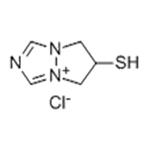Biapenem side chain is a pharmaceutical raw material that can be used to produce Biapenem antibiotics. Biapenem (LJC 10627) is a carbapenem antibiotic for injection developed by Japanese Lederle Company and American Cyanamid Company in 1989. It is now completed in Phase III clinical studies in Japan and waits for approval. The most significant feature of this product is that the S in 2-position has bicyclic triazole 1β-methyl carbapenem. The study of structure-activity relationship shows that the presence of the side chain quaternary ammonium cation center is the key to affect the permeability of the outer membrane, so that its ability to inhibit the activity of pseudomonas aeruginosa and anaerobic bacteria is 2~4 times that of imipenem, its ability to inhibit the activity of drug-resistant pseudomonas aeruginosa is 4 to 8 times that of Meropenem, and its effect on acinetobacter and anaerobic bacteria is more effective than ceftazidime.
Reference quality standards
Appearance: white to yellowish crystalline powder
Determination of content: 98%
Specific rotation:-26.0 ° to-36.0 °
pH: 4.5 to 6.0
Single Impurity: <1.0%
Total Impurities: <3.0%
Tetrahydrofuran and acetone: tetrahydrofuran less than 0.072%, acetone less than 0.5%
Loss on drying: no more than 1.0%
Residue on ignition: no more than 0.2%
Heavy metals: no more than 20ppm
The current status of Chinese imipenem drugs
Penem drugs are the antibiotics that have the most wide antibacterial spectrum and stronger antibacterial activity, and therefore play an important role for the last line of defense of serious anti-clinical infection. In recent years, the serious problem of drug-resistant bacteria make the use of these drugs in the global and domestic have a rapid growth, and the world has listed 6 drug types of imipenem-cilastatin, panipenem-betamipron, meropenem, biapenem (Biopenone Side Chain), ertapenem and doripenem. However, the penem drugs is clinically used as a second-line drug, the government's guiding principle for rational application of antibiotics and the expensive price all greatly limit the use expansion of these drugs. These factors determine that this class of drugs in the short term is still a "nobility" variety with high added value and small scale. In 2008, the terminal sales scale of penem drugs in Chinese market was 19.9 billion yuan (equivalent to US $ 278 million), accounting for 9% of the global total sales (nearly $ 3 billion). The sales mumble was about 12.43 million and the consumption of raw materials was 5~6 ton/year, in which domestic raw materials were 1.9 tons (1.8 tons of meropenem, 0.14 tons of imipenem) and accounted for 36%.
In the raw material export market of 2008, the raw materials export volume of the three major penem products of China (meropenem, imipenem and intermediate 4-AA) were respectively 6 tons, 1.3 tons and 40 tons, accounting for more than 60% of the global generic drug market demand for raw materials.
Since 2009, with the continuous growth of international market demand, China's technical costs of raw materials and intermediates gradually have advantages, especially meropenem shares a larger share in the international market and has a certain discourse power of price. In 2009, the annual export volume of meropenem and 4-AA is expected to reach 8 tons and 50 tons, with a growth rate of about 30%. Penem drugs will continue to grow rapidly and steadily according to their "rhythm".



